AMD FX-8370E CPU Review: Vishera Down to 95W, Price Cuts for FX
by Ian Cutress on September 2, 2014 8:00 AM ESTGaming Benchmarks
F1 2013
First up is F1 2013 by Codemasters. I am a big Formula 1 fan in my spare time, and nothing makes me happier than carving up the field in a Caterham, waving to the Red Bulls as I drive by (because I play on easy and take shortcuts). F1 2013 uses the EGO Engine, and like other Codemasters games ends up being very playable on old hardware quite easily. In order to beef up the benchmark a bit, we devised the following scenario for the benchmark mode: one lap of Spa-Francorchamps in the heavy wet, the benchmark follows Jenson Button in the McLaren who starts on the grid in 22nd place, with the field made up of 11 Williams cars, 5 Marussia and 5 Caterham in that order. This puts emphasis on the CPU to handle the AI in the wet, and allows for a good amount of overtaking during the automated benchmark. We test at 1920x1080 on Ultra graphical settings.
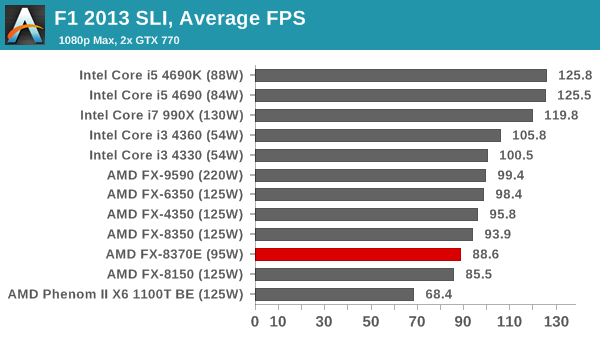
In all combinations, the 8370E and the 8150 duke it out. F1 2013 seems to be an Intel dominated title, given the i3 and outperform the FX-9590.
Bioshock Infinite
Bioshock Infinite was Zero Punctuation’s Game of the Year for 2013, uses the Unreal Engine 3, and is designed to scale with both cores and graphical prowess. We test the benchmark using the Adrenaline benchmark tool and the Xtreme (1920x1080, Maximum) performance setting, noting down the average frame rates and the minimum frame rates.
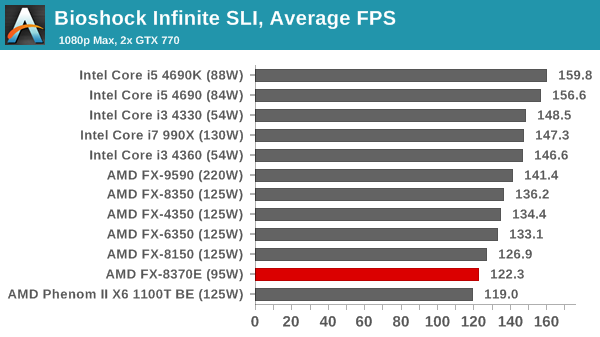
The FX-8350 again fits in just beneath the FX-8150, but for a lower power consumption.
Tomb Raider
The next benchmark in our test is Tomb Raider. Tomb Raider is an AMD optimized game, lauded for its use of TressFX creating dynamic hair to increase the immersion in game. Tomb Raider uses a modified version of the Crystal Engine, and enjoys raw horsepower. We test the benchmark using the Adrenaline benchmark tool and the Xtreme (1920x1080, Maximum) performance setting, noting down the average frame rates and the minimum frame rates.
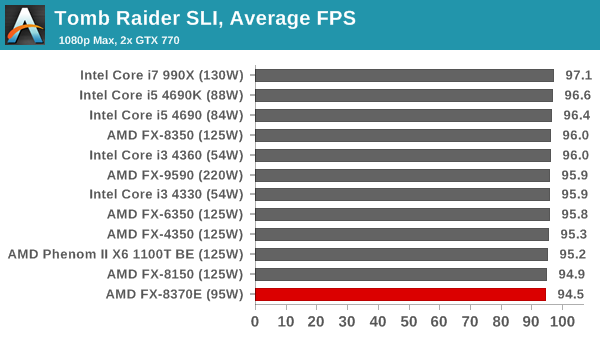
Tomb Raider continues to be CPU agnostic, even around the FX quad thread CPUs.
Sleeping Dogs
Sleeping Dogs is a benchmarking wet dream – a highly complex benchmark that can bring the toughest setup and high resolutions down into single figures. Having an extreme SSAO setting can do that, but at the right settings Sleeping Dogs is highly playable and enjoyable. We run the basic benchmark program laid out in the Adrenaline benchmark tool, and the Xtreme (1920x1080, Maximum) performance setting, noting down the average frame rates and the minimum frame rates.
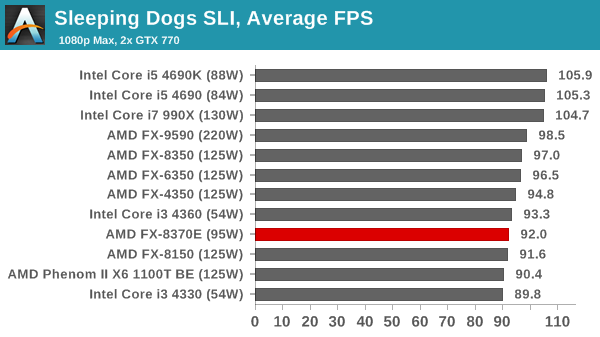
The eight threads offers some advantage in minimum frame rates, but average frame rates are still around the FX-8150.
Battlefield 4
The EA/DICE series that has taken countless hours of my life away is back for another iteration, using the Frostbite 3 engine. AMD is also piling its resources into BF4 with the new Mantle API for developers, designed to cut the time required for the CPU to dispatch commands to the graphical sub-system. For our test we use the in-game benchmarking tools and record the frame time for the first ~70 seconds of the Tashgar single player mission, which is an on-rails generation of and rendering of objects and textures. We test at 1920x1080 at Ultra settings.
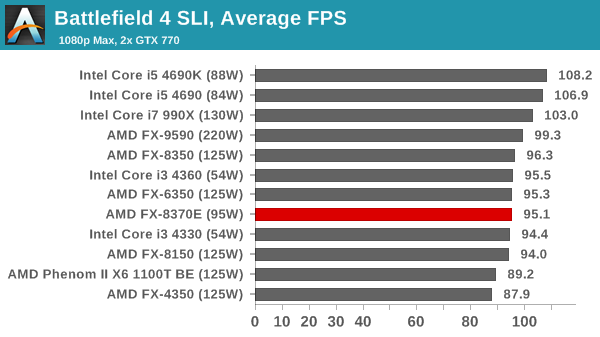
The FX-8370E stretches its legs a little in terms of minimum frame rates, particularly in SLI, however it is handily beaten by the i3-4330.















107 Comments
View All Comments
silverblue - Tuesday, September 2, 2014 - link
I remember a B3 stepping that never surfaced; perhaps the process improvements were baked into C0 along with the architectural tweaks.TiGr1982 - Tuesday, September 2, 2014 - link
That is what actually happened. The sad thing that since then AMD never really did something really new about FXes - not a single stepping, AFAIK.krumme - Tuesday, September 2, 2014 - link
"Strong data"?This is perhaps the single most unimportant x86 cpu ever. This is just feeding a complex Mubadala GF agreement leading to stagnation and brand erosion.
The strong data we have is that is a fat, expensive, power hungry cpu, only fit for a minimal minority. And it shows in the financial results for AMD. Its burning money faster than electricity.
Let this old tech die as soon as possible.
At 1998 or so it cost me aprox 50 usd, and 10 minutes, to upgrade the 200MHz K6 to a 400MHz K6-2 using the same MB. Thats more like it. This is not remotely the same value. Burn baby burn.
just4U - Tuesday, September 2, 2014 - link
It's not really a good comparison.. back then ( right up until the Athlon and later the Core2) You could get some pretty noticeable jumps. These days processor power has gone somewhat sideways /w features and efficiency rather than raw noticeable power. One of many reasons why people are holding onto their systems longer.. I still got lots of people on 5+ year old platforms running SSDs newer power supplies and new video cards but saying no.. their cpu is good enough.zebrax2 - Tuesday, September 2, 2014 - link
Can we get some idle power consumption numbers? The delta isn't really useful without a baselineEssence_of_War - Tuesday, September 2, 2014 - link
For a CPU review, I actually think the baseline is somewhat distracting. Baseline at idle is largely dependent on motherboard, for the CPU review, the delta is the important data point.mrdude - Tuesday, September 2, 2014 - link
So, and pardon me if I'm reading too much or too little into this, but AMD has released these 'new' processors in order to not find themselves in yet another Llano/FM1 situation where there's little uptake but big inventory of motherboards so as to avoid yet another massive write-off but this time on AM3+?Isn't the alternative of not embarrassing themselves and their partners by stamping AM3+ with a long overdue 'EOL' branding the better option here? Who on earth is even buying these things?It seems that AMD has erroneously conflated and misinterpreted the outcry from enthusiasts for a much needed, competitive AMD, and the sentiment of "I'd like to buy an AMD processor, but..." with the harsh reality of their currently not-at-all competitive and completely unattractive product line. They've still got two separate chipsets on the board, and those chipsets are essentially the same chipsets we saw back in 2007!!!
Personally, I'd much rather see AMD make a comprehensive and honest effort to open up about their future products and roadmaps and answer some important questions than re-release a product that should never have been released in the first place. If they want to retain the ears of enthusiasts, it would be wise to open their ears to enthusiasts first.
jann5s - Tuesday, September 2, 2014 - link
+1asimov1979 - Tuesday, September 2, 2014 - link
I totally agreeasimov1979 - Tuesday, September 2, 2014 - link
These would have been a good option back in 2012